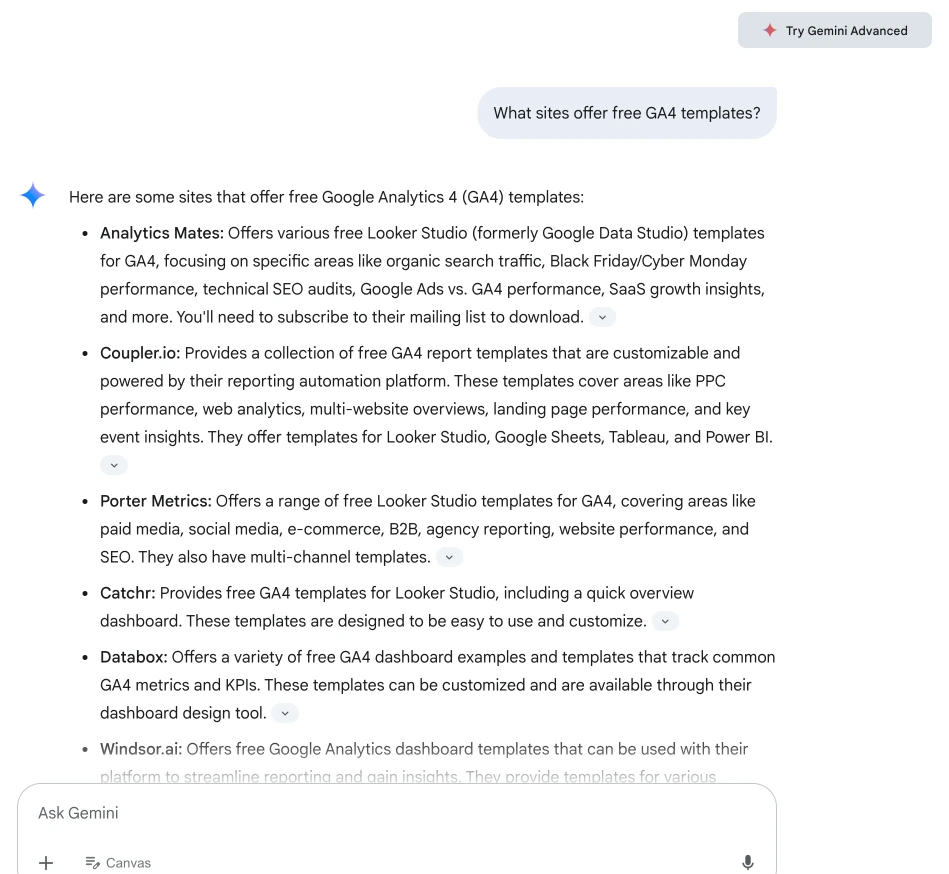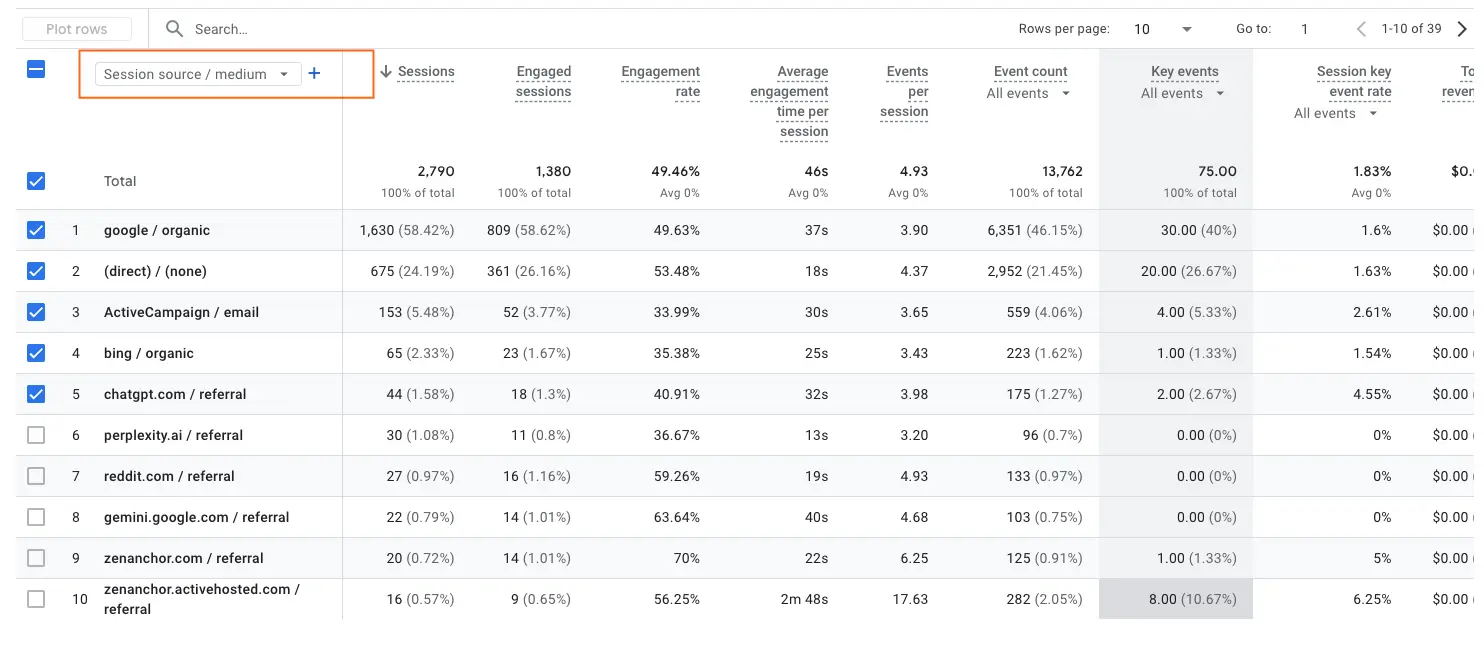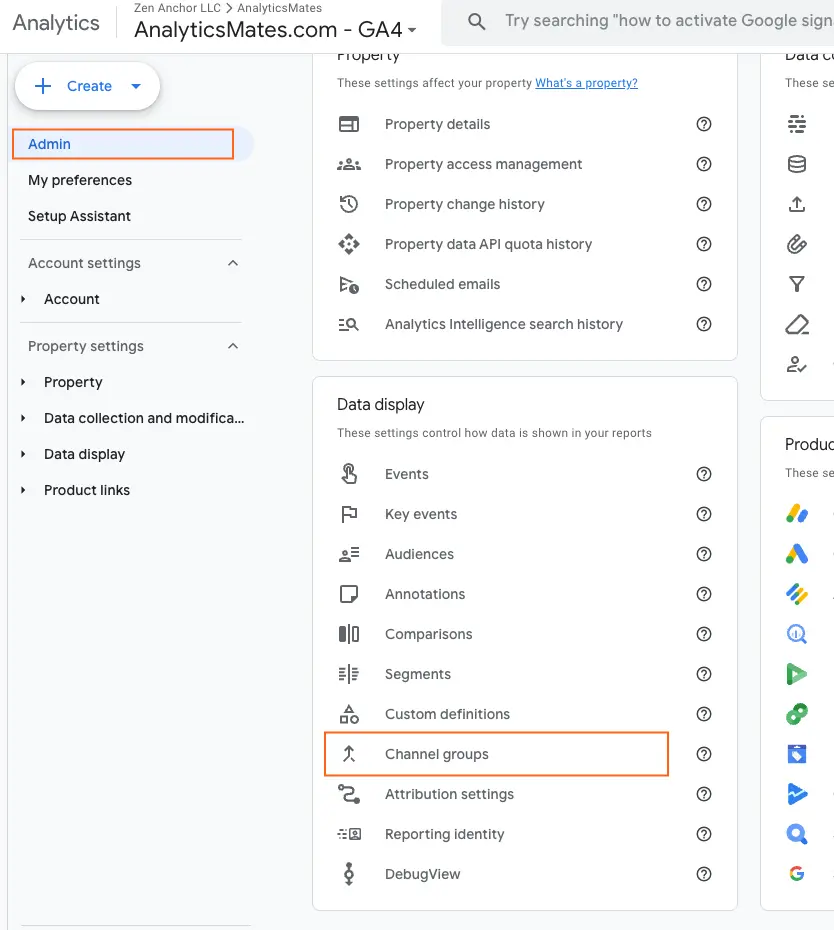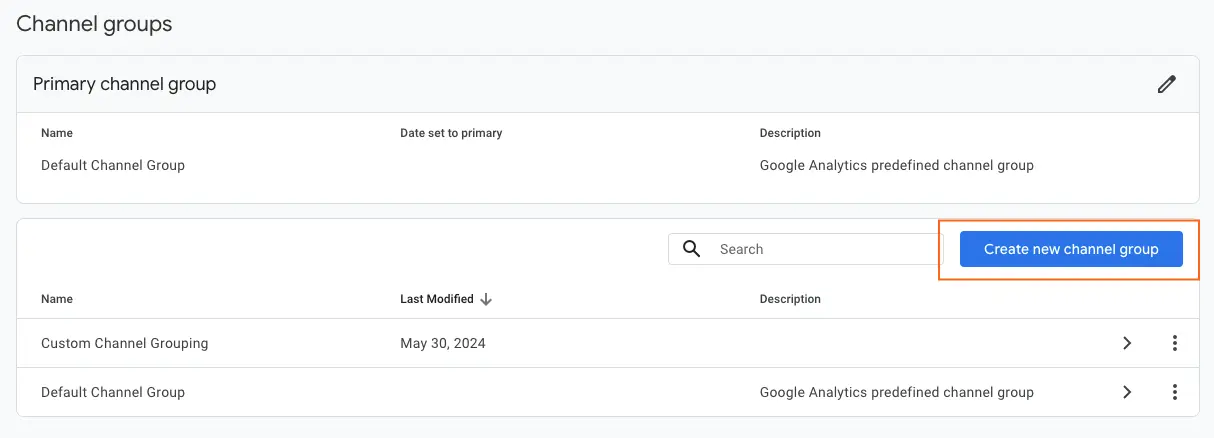Generative AI tools—like ChatGPT and others—are becoming a common way for users to discover new websites and services. People are now typing in questions like, “What sites offer free GA4 templates?” instead of using traditional search engines. This shift is changing how users find and engage with content online.
As marketers, it’s more important than ever to understand where your traffic, engagement, and conversions are really coming from. While GA4 helps us measure the performance of different channels, it’s still a challenge to identify traffic specifically coming from generative AI tools.
In today’s blog, we’re diving into that exact topic: how to track and measure traffic from generative AI using GA4. Whether these tools are bringing in leads or just helping users explore your content, knowing their impact is key to understanding the full picture of your website’s performance.
What are Generative AIs?
Generative AIs are tools that create content—like text, images, or code—based on user prompts. Instead of just searching and listing results, they generate new responses or suggestions. Many people now use them to ask questions, get recommendations, or discover services and websites.
Popular Generative AI Tools (as of 2025):
- ChatGPT (by OpenAI)
- Microsoft Copilot (built into Bing and Microsoft products)
- Google Gemini (formerly Bard)
- Claude (by Anthropic)
- Perplexity AI
- YouChat
- Jasper AI (popular for content creation)
- Writesonic
- Notion AI (built into Notion for productivity and writing)
- Copy.ai
These tools can browse the web (if connected), summarize content, and suggest services—making them a new kind of traffic source for websites.
Why More Users Are Turning to AI Instead of Traditional Search
It’s no surprise that more people are using generative AI to find services, tools, and recommendations. Unlike traditional search engines where users have to scroll through multiple pages of results, generative AI gives fast, direct answers.
Instead of typing “GA4 templates” into Google and browsing through several websites, a user can simply ask an AI tool, “Where can I find free GA4 templates?”—and get a quick, summarized list with links. It saves time and removes the need to compare dozens of tabs or filter through ads and irrelevant results.

AI tools also offer a more conversational experience. Users can ask follow-up questions, refine their search, and get tailored suggestions without having to restart the process.
For businesses, this means potential customers might find your site not from a Google search, but through a recommendation from a generative AI. That’s why it’s important to start recognizing this behavior and learning how to measure it in GA4.
How GA4 Identifies Traffic from Generative AI Tools
When someone clicks a link shared by a generative AI like ChatGPT or Bing Copilot, that visit is often logged in GA4 under “Referral” or “Direct” channels—depending on how the AI passes (or doesn't pass) source information. Unlike traditional search engines like Google or Bing, generative AI tools don’t always follow standard UTM tagging or referral rules, which can make tracking a bit tricky.
In many cases, traffic might show up as:
- Referral traffic from domains like chat.openai.com or copilot.microsoft.com
- Direct traffic if no referral data is passed (which is common in some tools)
To better understand this, let’s walk through how to check your GA4 reports for potential generative AI traffic.
How to View Generative AI Traffic in GA4 (Step-by-Step)
1. Log in to GA4: Go to analytics.google.com and select the property you'd like to check.
2. Go to Reports → Acquisition → Traffic Acquisition
This report shows you how users arrived at your website.

3. Change the Primary Dimension to "Session source/medium"

- This gives you a more detailed look at where sessions are coming from.
4. Use the Search/Filter bar to look for possible AI-related sources:
Try searching for:
- chat.openai.com
- copilot.microsoft.com
- bard.google.com (for older Gemini traffic)
- perplexity.ai
- Any other known AI tool URLs
5. Optional: Add Secondary Dimensions
- For deeper insights, add dimensions like “Session campaign,” “Page path,” or “Landing page” to understand where users landed and what they did.
6. Use UTM Parameters Where Possible
If you're sharing your links inside AI tools or communities, add UTM tags like utm_source=chatgpt or utm_source=generativeai so you can track these visits more clearly in the future.
Why Create a Custom Channel for AI-Generated Traffic?
By default, visits from tools like ChatGPT, Bing Copilot, or Perplexity AI are often grouped under the Referral or even Direct channel in GA4. While this is technically correct, it doesn’t give you a full picture of how users are really finding your site.
If you're serious about tracking the impact of generative AI tools on your traffic and leads, it’s worth creating a Custom Channel Grouping in GA4. This lets you separate AI-generated traffic into its own category—so you can measure performance, compare engagement, and report on it with clarity.
We’ve covered the basics of Custom Channel Grouping in detail in this guide:
Custom Channel Grouping in GA4: A Step-by-Step Guidance
Suggested Names for AI Traffic Channel Definitions
When setting up your custom channel, use a name that’s easy to understand and works with your reporting. Here are a few ideas:
- AI Discovery
- Generative AI
- AI Tools Traffic
- Chatbot Referrals
- AI Recommendation Sources
How to Set Up a Custom Channel Grouping for AI Traffic in GA4
A Quick Note on Default vs Custom Channel Grouping
While Google Analytics 4 allows you to modify your Default Channel Grouping, we recommend not editing it directly.
Here’s why:
- Once you change the default setup, it’s difficult to undo. GA4 doesn’t offer a simple “reset to default” option, so restoring the original definitions can be tricky and time-consuming.
- Editing the default channels may affect the consistency of your data over time. If team members aren’t aware of the changes, it could lead to confusion or inaccurate reporting.
Best Practice: Instead of changing the Default Channel Grouping, create a Custom Channel Grouping.
The great thing is—every custom channel grouping starts as a copy of the default, so you’re not starting from scratch. This gives you full control and flexibility without altering your core setup.
By doing it this way, you can confidently track traffic from generative AI tools (or any other new source) while keeping your baseline data structure clean and reliable.
Follow these steps to create a dedicated channel for traffic from generative AI tools:
1. Go to GA4 → Admin → Channel Groups

2. Under Channel groups page, click on Create new channel group

3. Give your new channel grouping a name (e.g. Channel Grouping + AI Data)

4. Click Add new channel and name it (e.g. Generative AI)

5. Set the conditions:
- Match 'Session source' or 'Source'
- Example values to include:
- chatgpt.com
- gemini.google.com
- perplexity.ai
- copilot.microsoft.com
- bard.google.com or gemini.google.com
- Example values to include:
- Use “contains” or “matches regex” for flexibility
![GA4 "Create new channel" interface with the name "Generative AI" and conditions set to include traffic from sources containing "[invalid URL removed]," "gemini.google.com," "perplexity.ai," or "copilot.microsoft.com.](https://cdn.prod.website-files.com/62dec02b8093ac60c15793a2/67fd9f29fa3e82695e00cd6f_img_8.webp)
6. Add any other conditions if needed (like medium = referral)
![A portion of the GA4 "Create new channel" interface showing channel conditions. It's set to match traffic where the "Source" contains "[invalid URL removed]," "gemini.google.com," "perplexity.ai," OR "copilot.microsoft.com," AND where the "Medium" exactly matches "referral." The "Medium" condition is highlighted with an orange box.](https://cdn.prod.website-files.com/62dec02b8093ac60c15793a2/67fd9f47004e4c193b328df4_img_9.webp)
7. Set the rest of your channel definitions as needed, or use default settings for other channel
8. Click Save channel
9. (Optional): To reorder the channels, click Reorder, then drag and drop the channel definition to your preferred position. Once done, click Apply.
10. Once you're happy with the setup, click Save Group to finalize your custom channel grouping.
11. (Optional): To set a primary channel grouping, click the pencil icon on the Channel Groups configuration page and choose your preferred grouping.

Important Notes to Remember When Creating Channel Groups in GA4
Custom Channel Grouping is a powerful feature in GA4 that helps you organize and report on your traffic sources in a way that’s tailored to your business. While the default channel group works for many standard use cases, creating custom groupings allows you to better reflect how visitors truly find and engage with your site—especially with newer traffic sources like generative AI tools.
Here are the key points to remember when working with channel groups in GA4:
General Functionality
- A channel group is a set of traffic source categories (channels), defined by rules you set.
- You can use custom channel groups as a primary or secondary dimension in standard reports like Acquisition, Events, and more.
- Custom channel groups are also available in explorations, audience conditions, and custom reports.
Channel Group Creation
- All new custom groups start as a copy of the default channel group or an existing custom one.
- You can edit, add, remove, or reorder channels within a custom group.
- Traffic is counted in the first matching channel based on the order of definitions.
- It’s best to keep the Default Channel Group untouched to avoid disrupting existing data accuracy.
Custom vs Default Channel Groups
- Custom channel groups allow for better categorization, such as isolating AI traffic from general referrals.
- Do not edit the Default Channel Group—you can't easily revert it, and changes may confuse future reports.
- Every time you create a custom group, it duplicates the current Default Channel Group as a base.
Reporting Behavior
- Custom channel groups can be applied retroactively to historical data.
- However, they do not support certain reports like Key Events Paths.
- Cost, click, and impression metrics are not available for the “Manual ad content” field when used in custom group definitions.
Limits
- Standard GA4 properties can have:
- Up to 2 custom channel groups
- Up to 50 channels per group
- GA4 360 properties (including sub and roll-up properties) can have:
- Up to 5 custom channel groups
- Still up to 50 channels per group
FAQs: Tracking Generative AI Traffic in GA4
1. Can generative AI traffic influence my SEO reports in GA4?
No, generative AI traffic is not classified as organic search in GA4. It's typically grouped under Referral or Direct unless explicitly tagged. However, if users return via branded search after first discovering you through AI, that journey may show up in SEO-related paths.
2. How can I tell if traffic from generative AI led to conversions?
Use Explorations or Conversion Paths with your custom channel group to analyze session behavior and conversions. If you’ve created a “Generative AI” channel, you can filter by that to measure goal completions or purchase behavior.
3. Should I tag links I submit to AI tools with UTMs?
Yes! If you're contributing links in communities, forums, or even prompting AI tools like ChatGPT to recommend your content, using UTM tags like utm_source=chatgpt or utm_medium=ai is a smart way to ensure accurate tracking in GA4.
4. What’s the difference between “Direct” and “Referral” in the context of AI traffic?
Referral traffic means the AI passed a referring domain (e.g., chat.openai.com). Direct traffic means no referral data was sent—common when links are opened in new tabs or apps with privacy constraints.
5. Can I segment returning users who originally came via a generative AI tool?
Yes. Use GA4 Audiences or Explorations to create a segment where the first session source equals your “Generative AI” channel. You can then track how those users behave on return visits.
6. Is it possible to distinguish between different AI tools in one channel group?
Absolutely. Within a single custom channel group, you can define individual channels like “ChatGPT,” “Gemini,” or “Perplexity” using their respective referral sources or UTM values.
7. Are AI tools compliant with privacy policies when sending traffic data?
Not always. Some tools intentionally avoid passing referral information due to privacy or technical limitations. This is why many AI-generated visits appear as “Direct.” It’s not a bug—it’s by design.
8. Can traffic from AI tools increase bounce rates?
Yes. If users click on your link in a generative AI response but find the page doesn’t meet their expectations, they may leave quickly. Use landing page and engagement metrics to identify high-bounce AI sessions and optimize content accordingly.
9. Will GA4 ever natively categorize generative AI as a default channel?
Possibly in the future, as usage grows. But for now, you need to manually define AI traffic using custom channel groups. Keep monitoring GA updates—this is a fast-moving space.
10. How do I future-proof my setup as new AI tools emerge?
Use flexible regex patterns in your custom channel rules (e.g., .*ai.* or contains “chat”) to capture new sources. Review your reports monthly to spot unknown referrals and update your custom grouping as needed.
Final Thought
As generative AI tools become a bigger part of how people discover content online, it’s important to evolve how we track and understand our web traffic. GA4 may not label AI traffic out of the box—but with a few smart steps, you can shine a light on this growing channel.
Start small: explore your reports, set up custom channel groupings, and tag your links. These efforts will give you clearer insights, better decision-making, and a more accurate view of how users are truly finding your site.
Staying ahead means staying informed—and now you are.
Thank you for reading!
We're always looking for ways to improve our Google Analytics 4 blog content. Please share your feedback so we can make it even better.







%20Data%20in%20GA4.webp)





